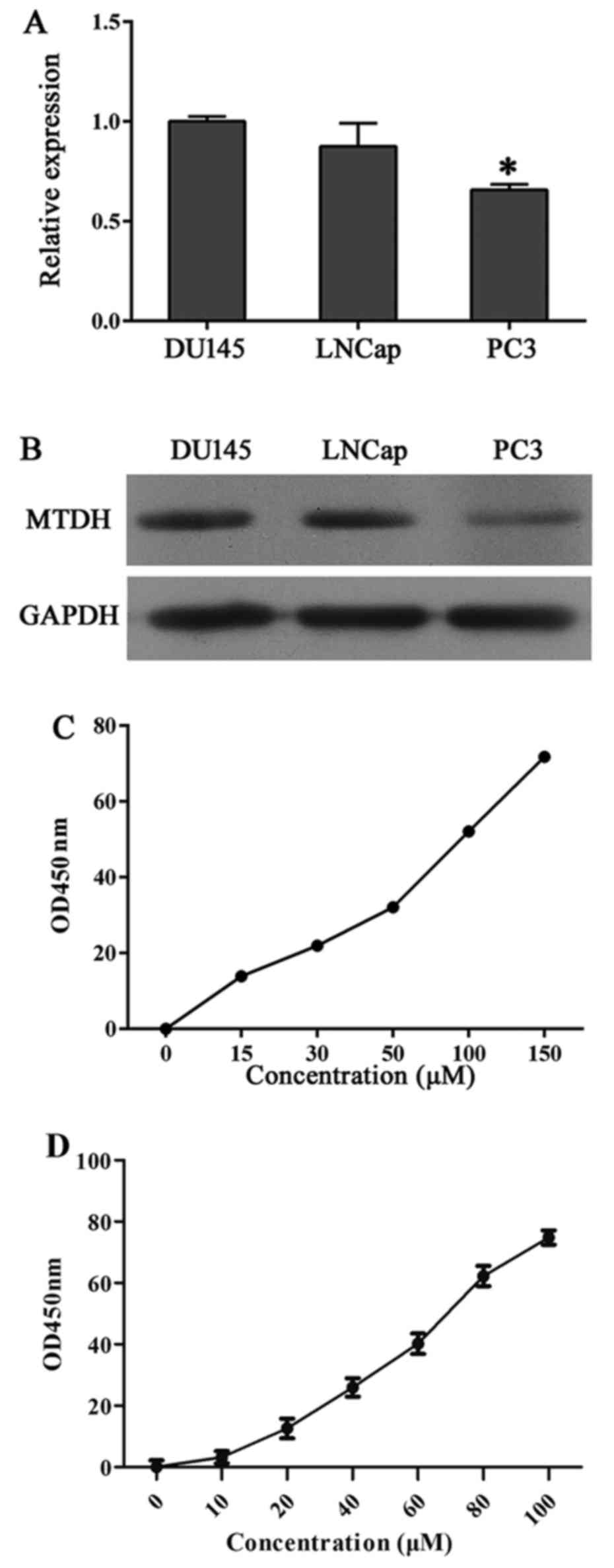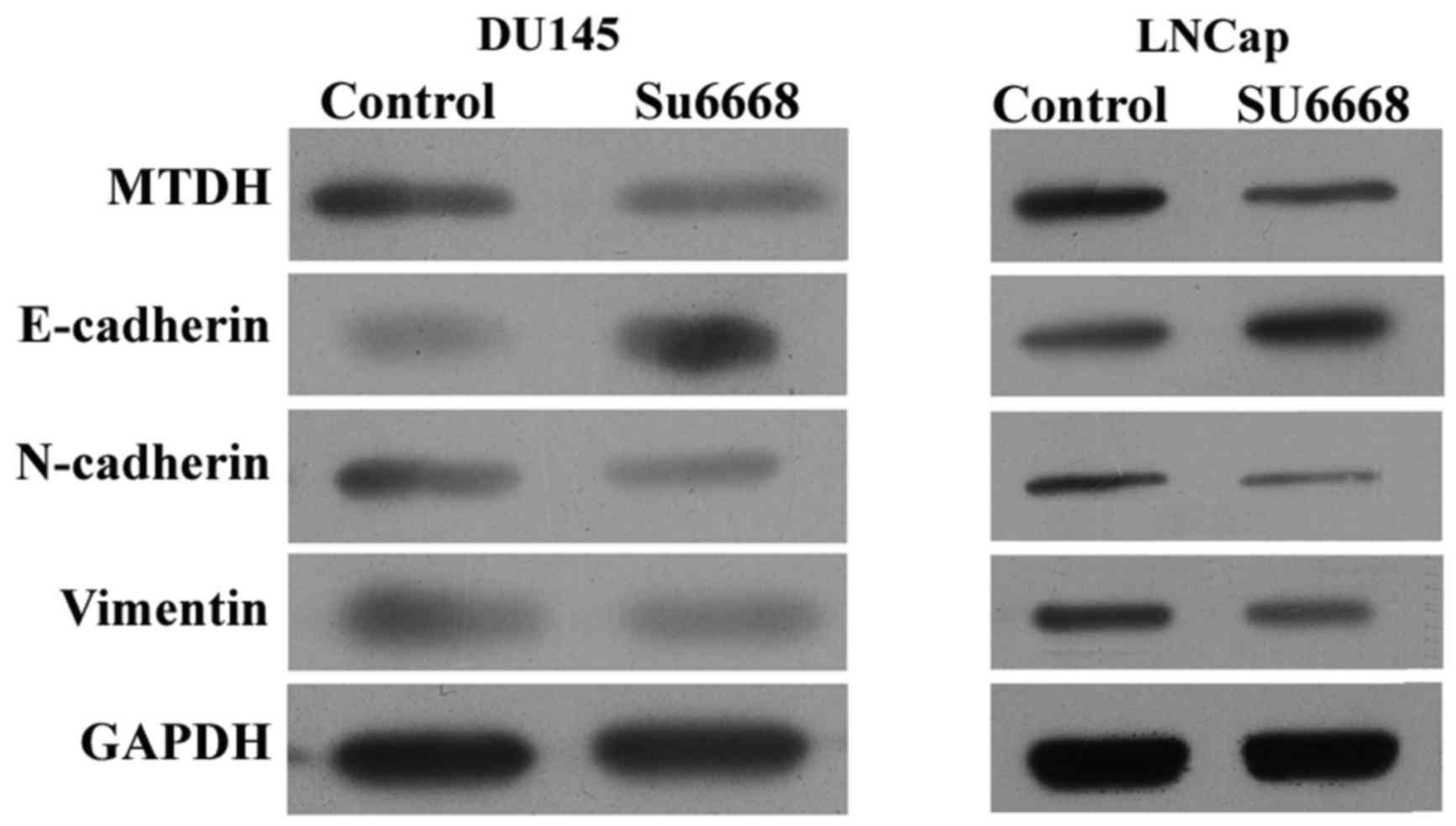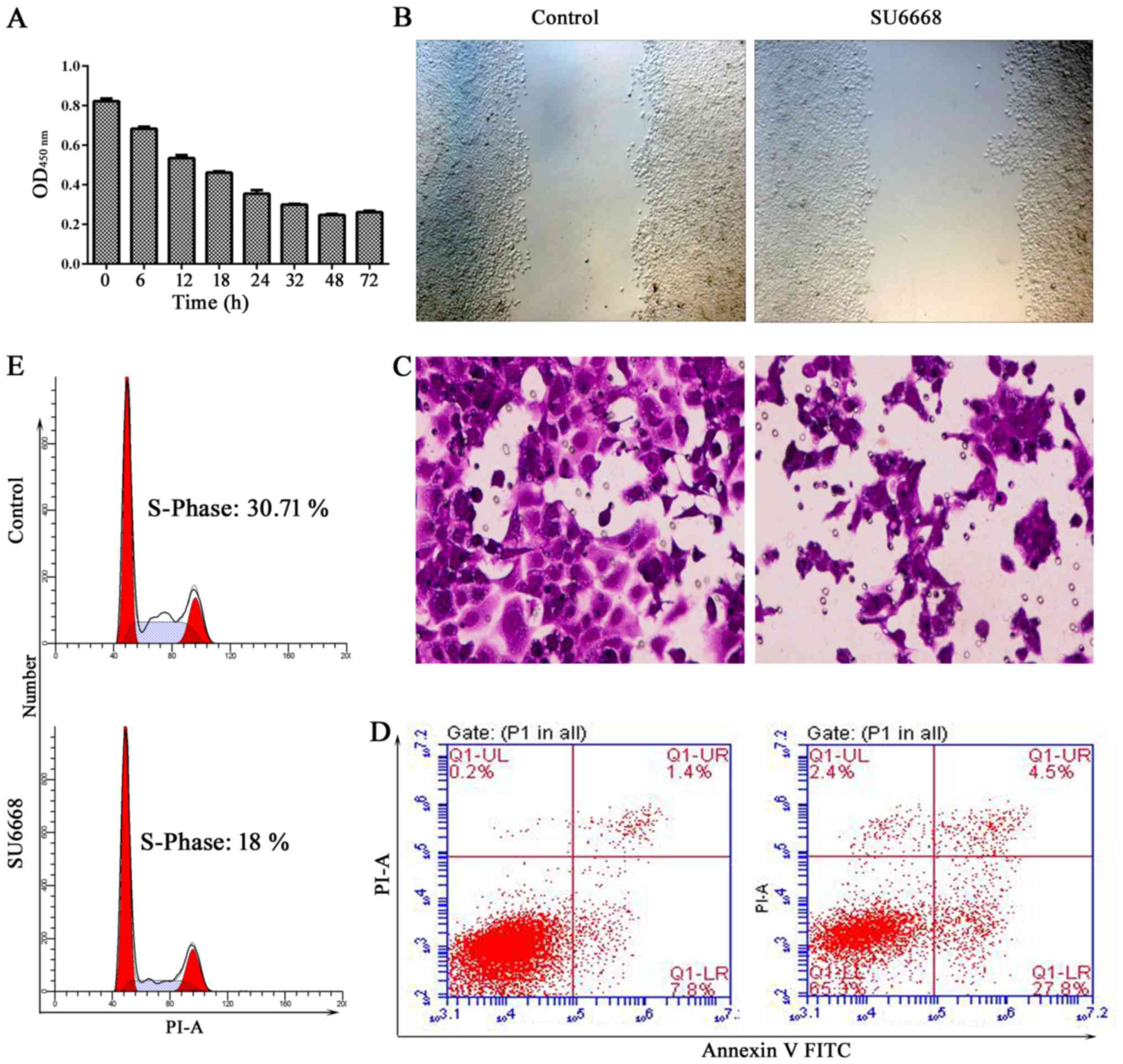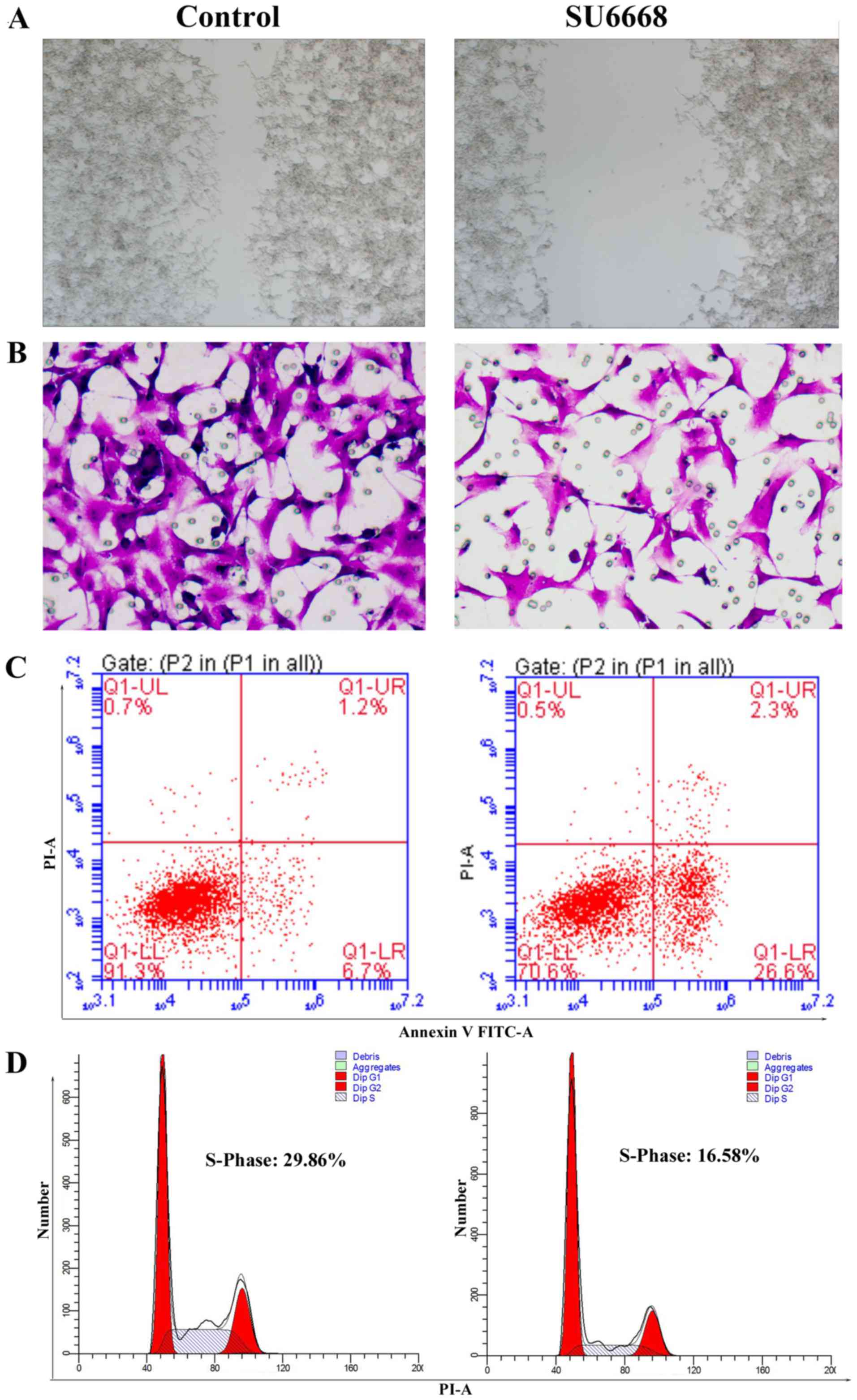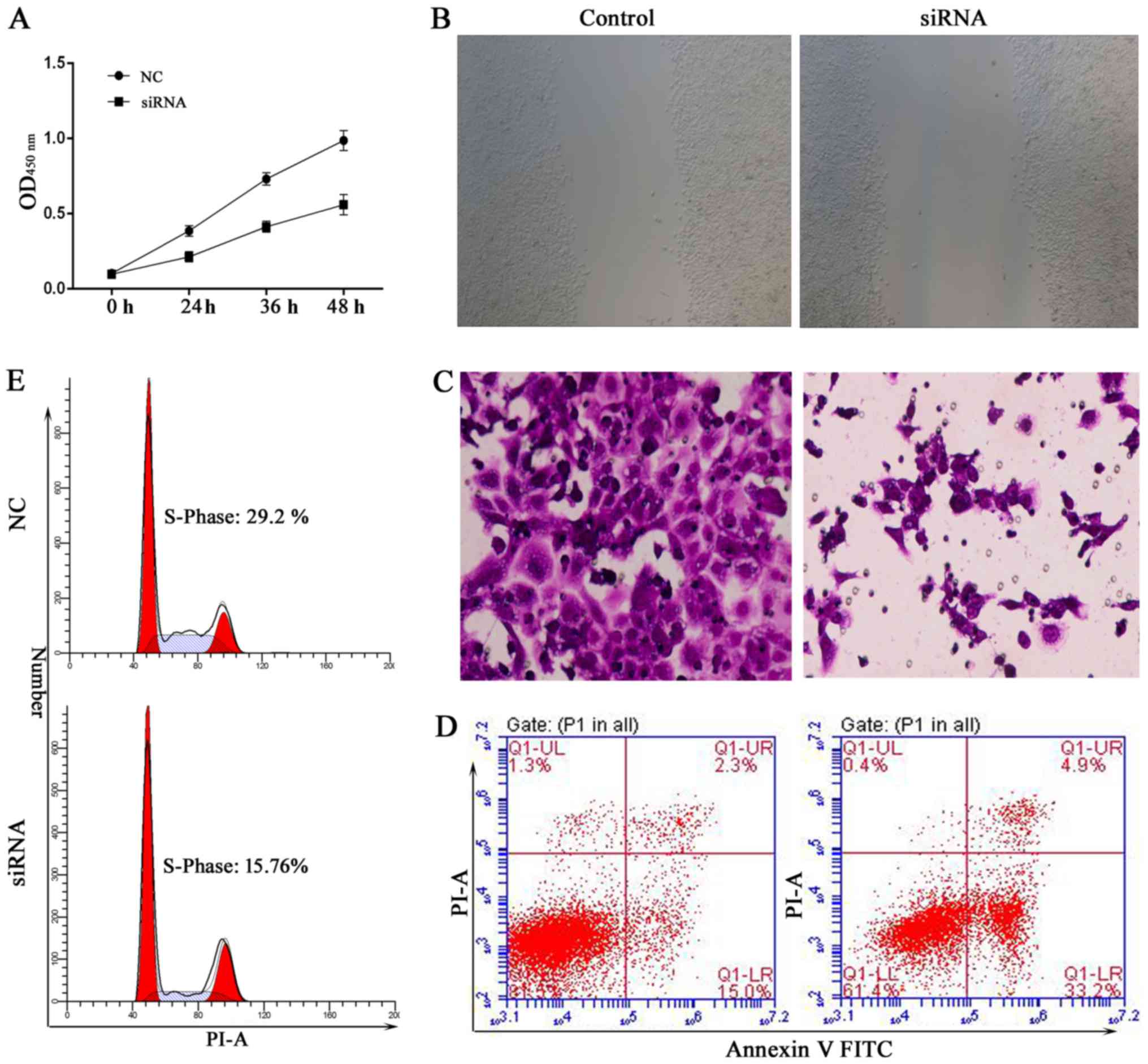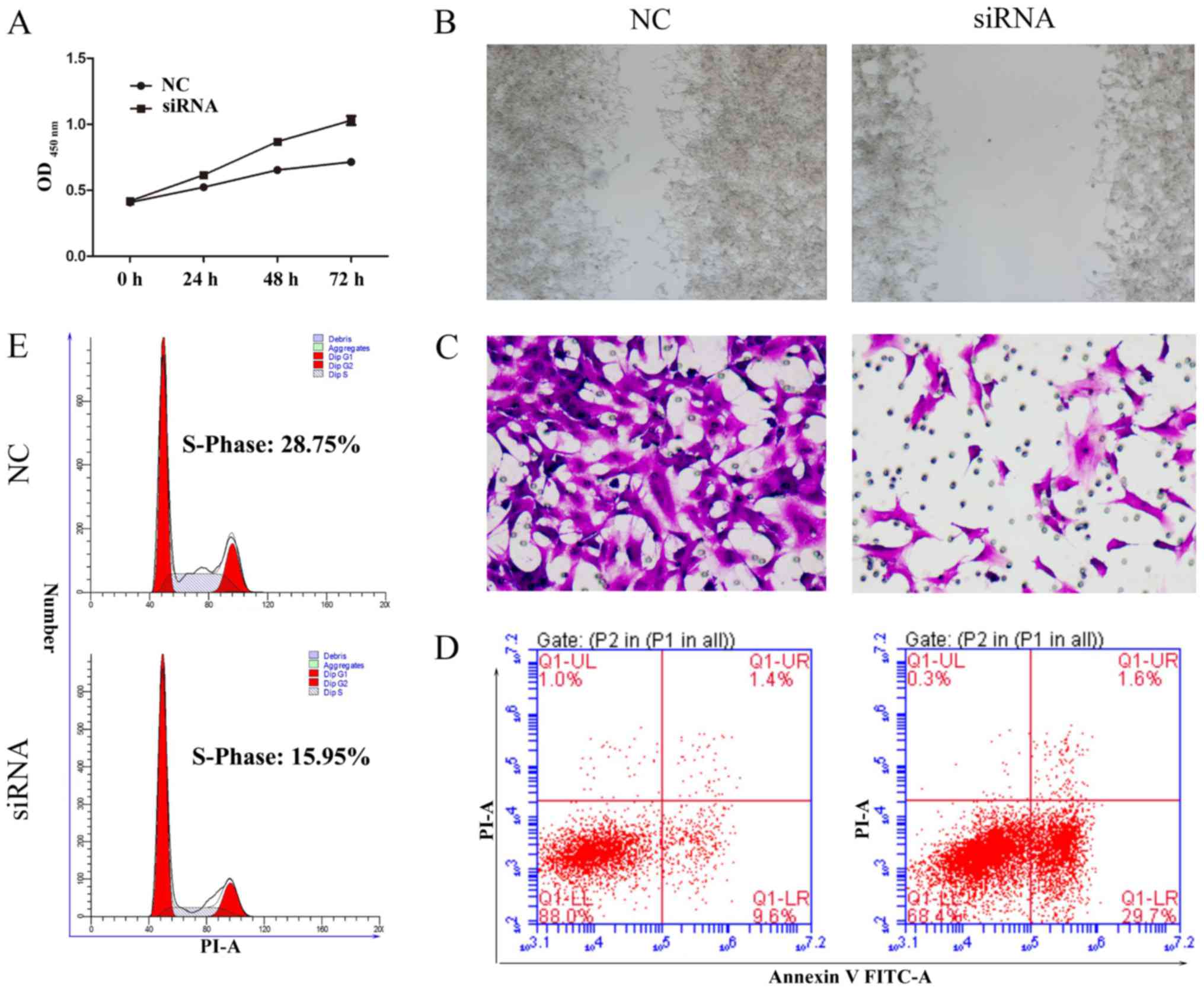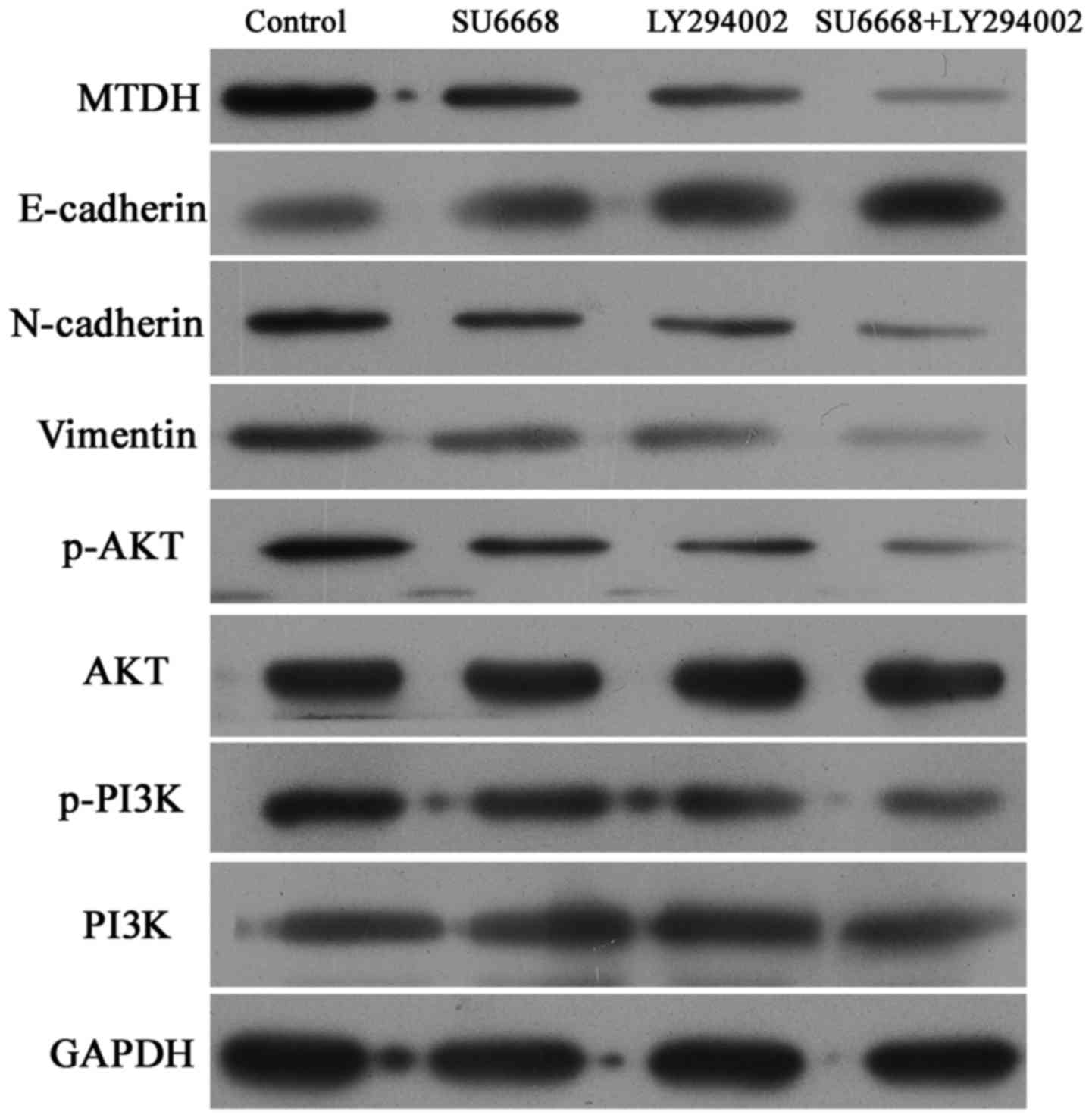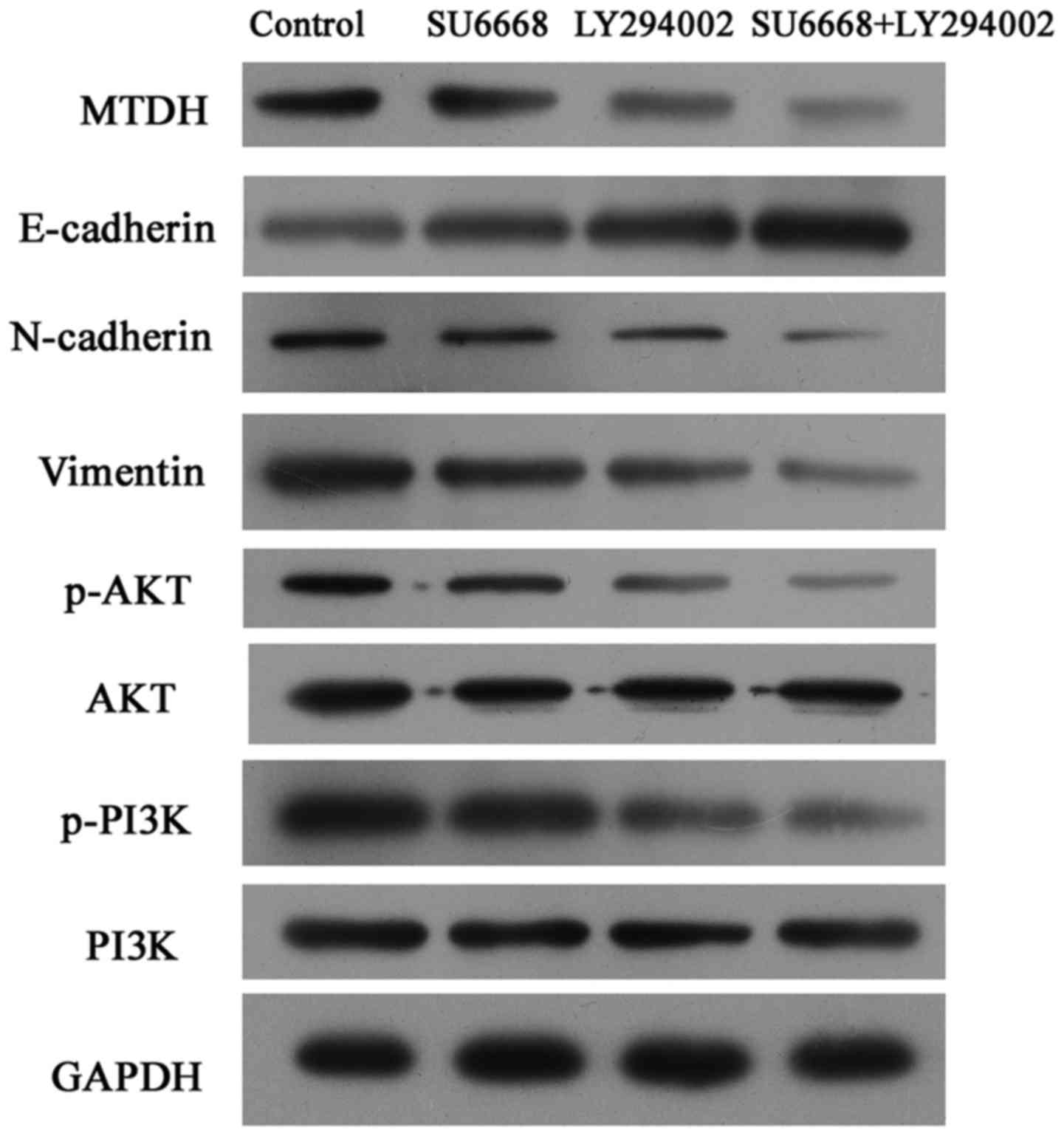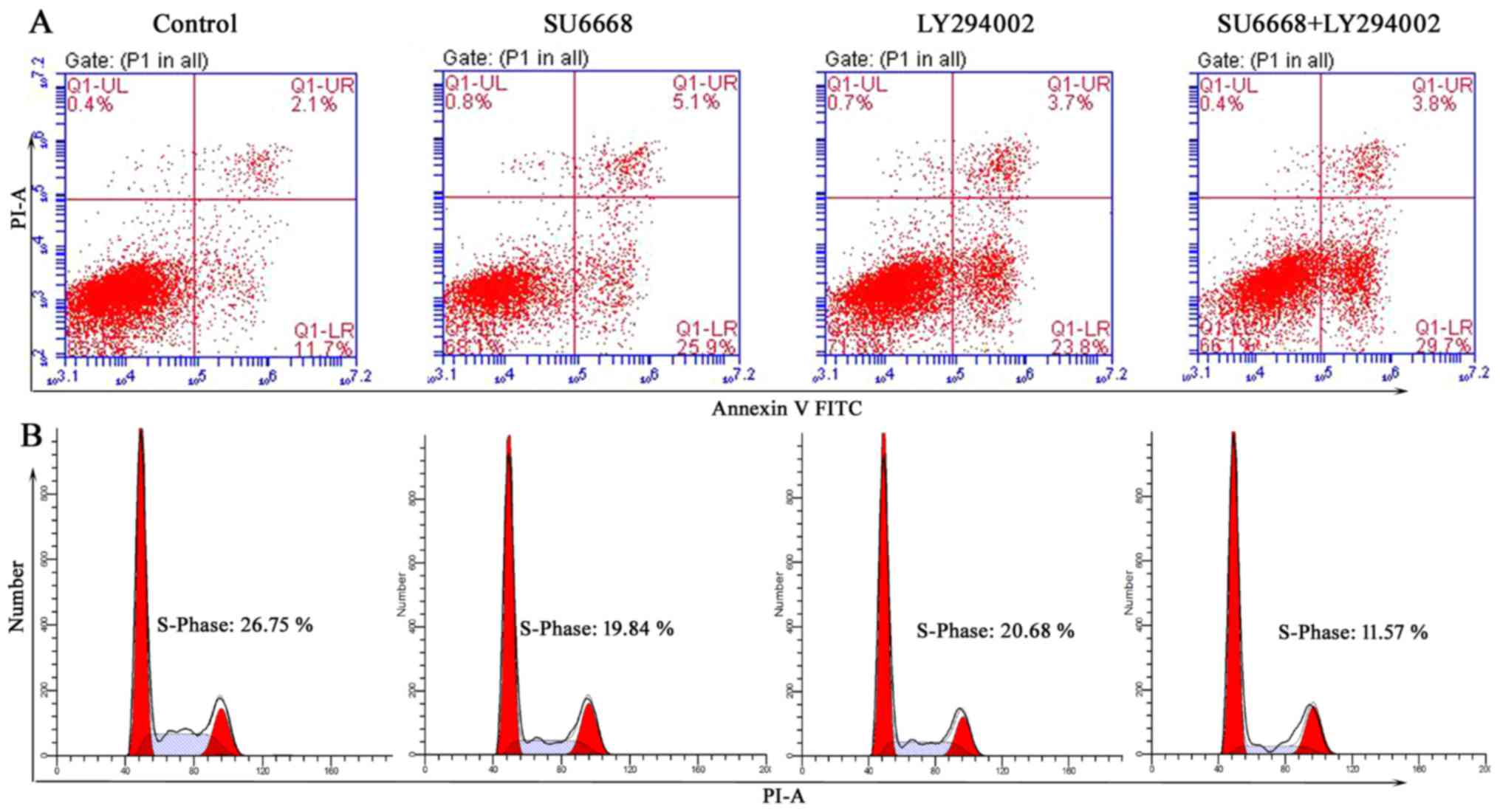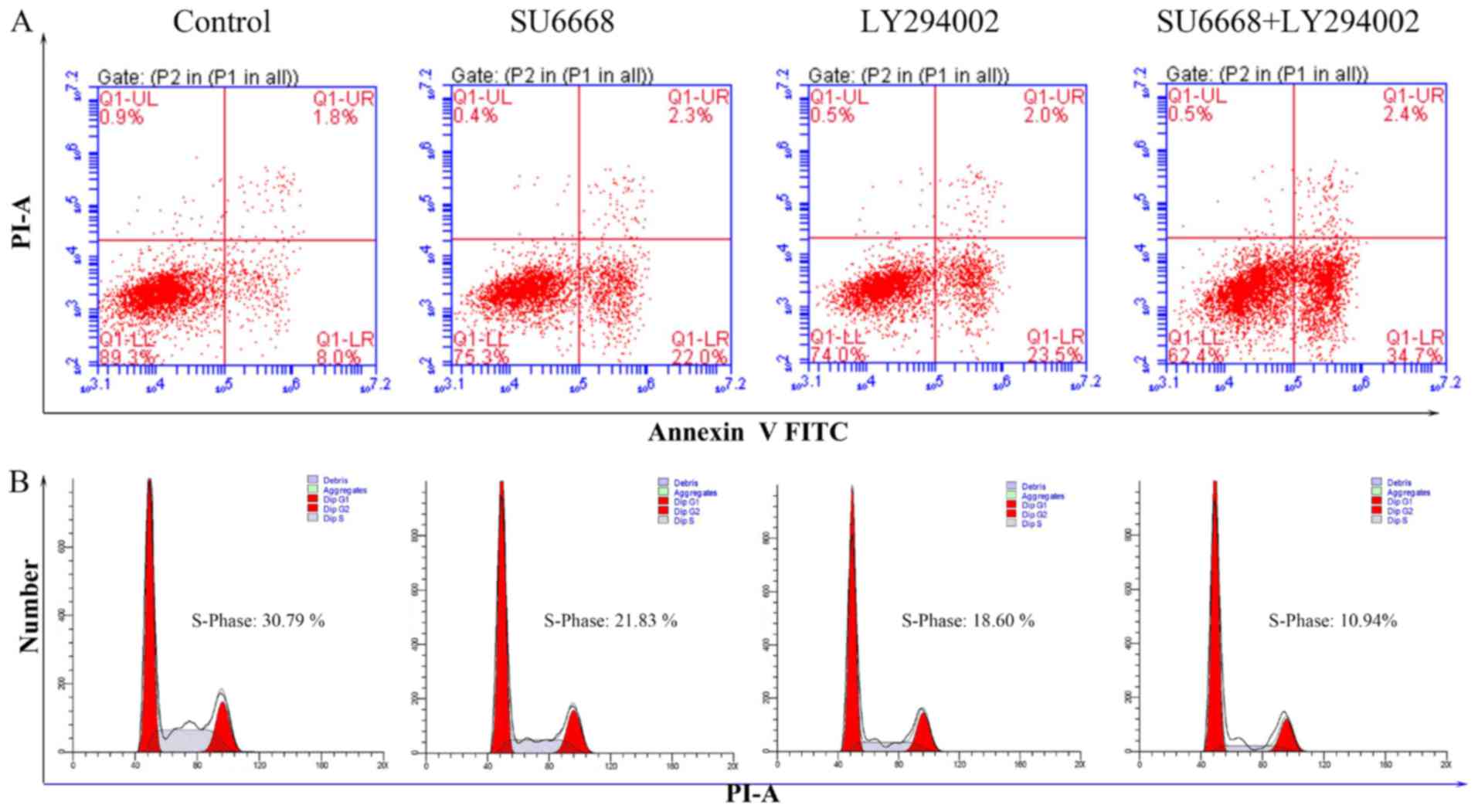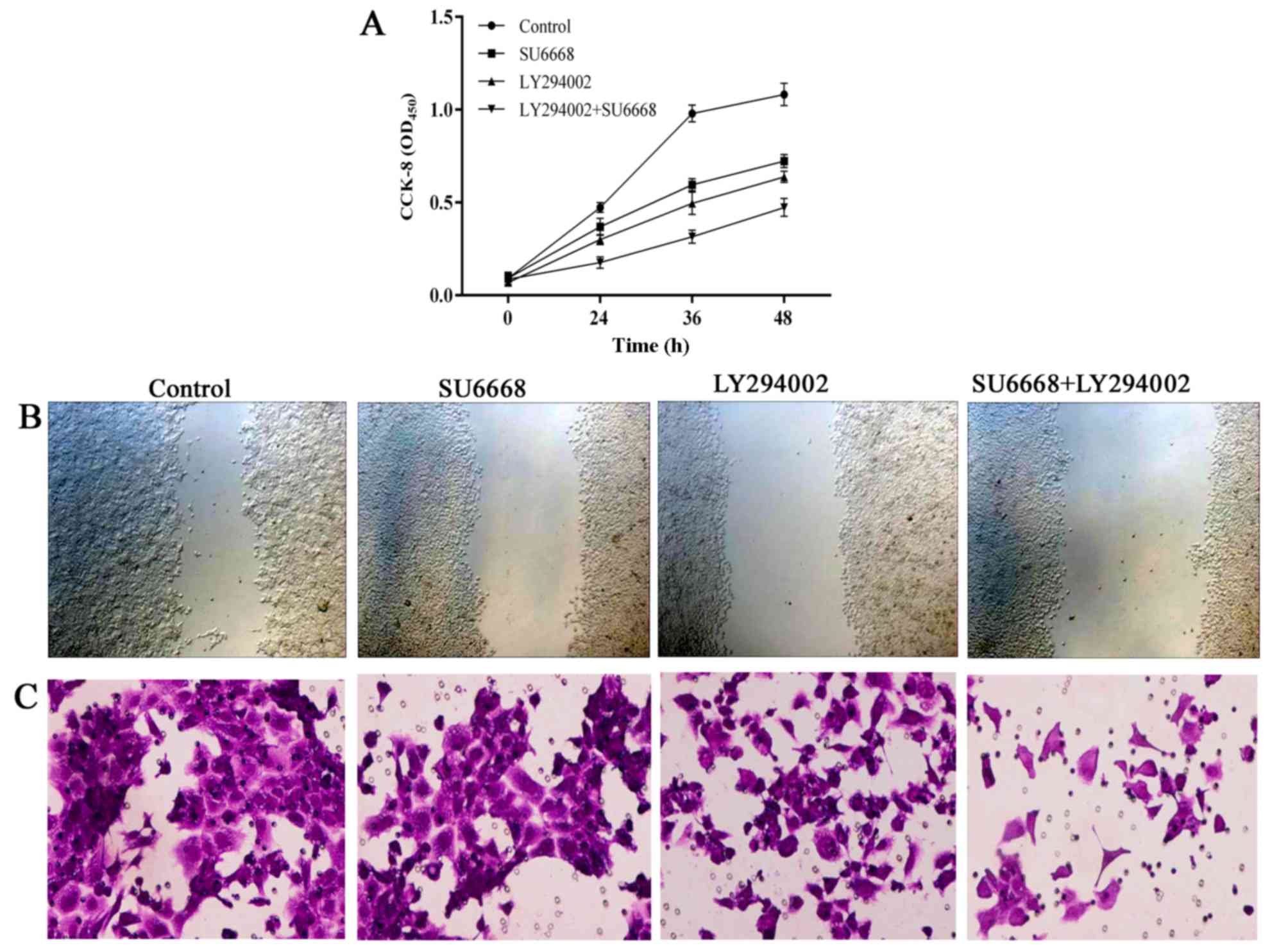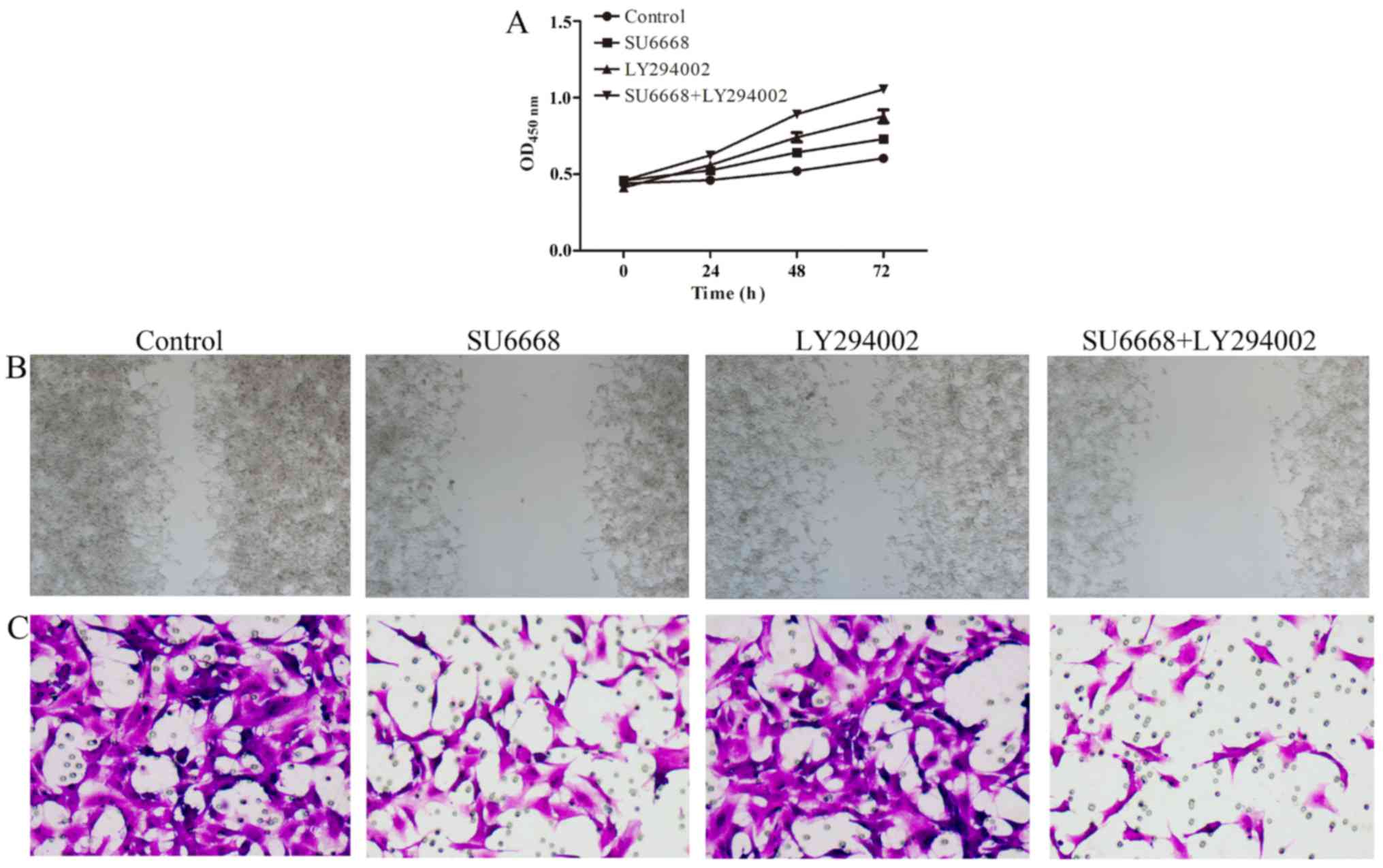SU6668 modulates prostate cancer progression by downregulating MTDH/AKT signaling pathway
- Authors:
- Published online on: March 22, 2017 https://doi.org/10.3892/ijo.2017.3926
- Pages: 1601-1611
-
Copyright: © Qian et al. This is an open access article distributed under the terms of Creative Commons Attribution License.
Abstract
Introduction
Prostate cancer is the second most frequently diagnosed cancer in men world-wide (1,2). In China, the incidence rates of prostate cancer have been increasing dramatically in the last 10 years, partly due to the gradual increase of the aging population and wide use of screening tests. The current screening methods are the prostate-specific antigen (PSA) test, digital rectal examination (DRE) and transrectal ultrasonography (TRUS)-guided random biopsy (3,4). Most prostate cancers (93%) are found when the disease is confined to the prostate and nearby organs. Patients who are diagnosed with localized prostate cancer and treated with radical prostatectomy often respond well to therapy. However, approximately 30% of patients will endure a relapse, and the 5-year survival rate declines from 90% for localized prostate cancer to 28% for metastatic prostate cancer (5). Although the diagnosis and treatment modality for primary prostate cancer has improved, there are still no curative treatments for metastatic prostate cancer at the current time (6). Therefore, identifying new biomarkers and therapeutic strategies may prove beneficial to prevent progression and metastasis of this disease.
The sustained growth of solid tumors is dependent on angiogenesis; receptor tyrosin kinases (RTKs), which participate in the proliferation, invasion and survival, signal from tumor cells and stromal cells to endothelial cells that comprise the tumor vasculature (7). Evidence for the direct role of vascular endothelial growth factor (VEGF), basic fibroblast growth factor (bFGF) and platelet-derived growth factor (PDGF) in angiogenesis has been well documented (8). SU6668 is a small molecular weight synthetic kinase inhibitor of fetal liver kinase-1/kinase insert domain-containing receptor (Flk-1/KDR), PDGF receptor β (PDGFRβ) and FGF receptor 1 (FGFR1), for VEGF, PDGF and bFGF, respectively (8,9). SU6668 binds to these three tyrosine kinase receptors and competitively inhibits their phosphorylation, thereby producing inhibitory effects on vascular endothelial cell growth. The ability of SU6668 to inactivate signaling makes SU6668 well adapted to inhibit multiple tumor signal transduction pathways critical to tumor cell growth and survival (10). Until now, the function and molecular mechanism of SU6668 in angiogenesis has been well established. However, studies evaluating the role of SU6668 in tumor cells are very rare and some studies have reported conflicting results (9,11). Laird et al (9) demonstrated that SU6668 is not a potent inhibitor of human cancer cells grown in culture. In contrast, Wang et al (11) in 2013 found that SU6668 directly suppresses the proliferation of triple-negative breast cancer cells. These conflicting findings suggest that the role of SU6668 in human cancer cells needs to be further studied. Moreover, the effect and potential molecular mechanism of SU6668 in prostate cancer have not been analyzed in detail and thus still require clarification (12–15).
Metadherin (MTDH), also known as astrocyte elevated gene-1 (AEG-1), was first identified in primary human fetal astrocytes exposed to HIV-1 in 2002 (16–18). MTDH is overexpressed in many tumor tissues and is considered a novel oncogene (19–21). Aberrant expression of MTDH is highly correlated with cell proliferation, migration, invasion, apoptosis and angiogenesis in a wide range of solid cancers, including breast cancer, glioblastoma, gastric and prostate cancer (22–26).
In the present study, we found that SU6668 inhibited proliferation, invasion and epithelial-mesenchymal transition (EMT) of prostate cancer cells. After SU6668 treatment, MTDH protein, which has been reported to be significantly overexpressed in many human tumor tissues, was downregulated in DU145 and LNCap cells. Mechanistic investigations identified that the AKT signaling pathway was inhibited after SU6668 treatment in prostate cancer cells. Taken together, our findings revealed that SU6668 suppressed prostate cancer progression by downregulating the MTDH/AKT signaling pathway.
Materials and methods
Cell cultures
The human prostate cancer cell lines DU145, LNCap and PC3 were maintained in RPMI-1640 (Gibco/Invitrogen, Sao Paulo, Brazil) supplemented with 10% fetal bovine serum (FBS) and 1% penicillin/streptomycin. All cell lines used in the present study were cultured in a humidified environment containing 5% CO2 and held at a constant temperature of 37°C.
Real-time PCR
Total RNA was extracted using TRIzol reagent (Invitrogen) and reverse transcribed using the transcriptase cDNA synthesis kit (Promega, Fitchburg, WI, USA) according to the manufacturer's instructions. Real-time PCR analysis was performed using SYBR Premix Ex Taq™ (cat. no. RR420A; Takara, Dalian, China) in an Applied Biosystems 7500 Real-Time PCR system according to the manufacturer's instructions. Primers (F, AAGCAGTGCAAAACAGTTCACG and R, GCACCTTATCACGTTTACGCT) for MTDH mRNA expression detecting was synthetized by Sangon Biotech, Co., Ltd. (Shanghai, China).
Cell Counting kit-8
Cells were seeded in 96-well plates and the proliferation of the cells was assayed at 0, 24, 36 and 48 h using Cell Counting kit-8 (CCK-8; Dojindo Laboratories, Kumamoto, Japan) according to the manufacturer's instructions. Cell viability was assessed by the measurement of absorbance at 450 nm using a microplate reader.
Western blot analysis
Cells were treated in 6-well plates, washed three times by phosphate-buffered saline (PBS) and lysed for 10 min on ice in radioimmunoprecipitation assay (RIPA) buffer containing an anti-protease mixture. Protein concentration was measured by bicinchoninic acid assay (BCA). The protein fractions were resuspended in loading buffer and denatured at 100°C for 10 min. Total proteins (20 µg/lane) were separated on 10% SDS polyacrylamide gels and transferred to polyvinylidene fluoride (PVDF) membranes. The membranes were then blocked in 5% fat-free milk Tris-buffered saline, 0.1% Tween-20 (TBST) buffer for 2 h at room temperature. Primary antibodies were used according to the manufacturer's instructions.
Cell migration and invasion assays
Wound healing assay was used to assess cell migration. The migration was assessed by measuring the movement of cells into a scraped area created by a 200 µl pipette tip. Afterwards, cells were cultured in media supplemented with 0.1% FBS to eliminate the effect of cell proliferation.
Cell invasion was examined using a reconstituted extracellular matrix membrane. Cells suspended at 4×104 cells/0.5 ml in serum-free media were placed in the top chambers and complete medium was added to the bottom chambers. The chambers were then incubated for 24 h. After incubation, the medium was removed from the top and bottom wells; the chambers were fixed with methanol for 30 min and then stained with crystal violet for another 30 min.
Cell cycle
Cells were harvested, washed once in PBS, and fixed in 70% ethanol for 48 h. The nuclei were stained with 50 µg/ml propidium iodide (PI) in 1% Triton X-100/PBS containing 100 µg/ml DNase-free RNase, and the DNA content was analyzed by flow cytometry. The percentage of cells in each phase of the cell cycle was determined using the ModFit LT program.
Cell apoptosis
Cell apoptosis was evaluated using a FITC-Annexin V apoptosis detection kit. Briefly, cells were harvested and washed with cold PBS, then were centrifuged at 1000 rpm for 5 min, and the pellet was resuspended in binding buffer in a 1.5-ml culture tube and later incubated with 5 µl of a FITC-conjugated Annexin V and 5 µl PI for 10 min at room temperature in the dark. The samples were analyzed by flow cytometry.
Statistical analysis
Data in this study were analyzed using Predictive Analystics Software (PASW) Statistics for Windows (version 18.0; SPSS, Inc., Chicago, IL, USA). All experiments were conducted at least three times. Values were presented as the mean ± standard deviation (SD). The statistical significance of differences between independent groups was determined by one-way analysis of variance (ANOVA). P-values <0.05 were considered statistically significant.
Results
SU6668 downregulates the expression of MTDH in prostate cancer cells
It has been reported that MTDH is associated with cancer cell proliferation and invasion (9,11). To evaluate whether MTDH was affected during SU6668 inhibition of cancer cell progression, we first examined the protein expression level of MTDH in DU145, LNCap and PC3 cells (Fig. 1A and B). The results showed that DU145 and LNCap cells expressed higher levels of MTDH compared with the other cell lines than the PC3 cells, so DU145 and LNCap cells were chosen for our experiments. Furthermore, IC50 of DU145 and LNCap to SU6668 was measured through CCK-8 at concentration of 0, 15, 30, 50, 100 and 150 µM and 0, 10, 20, 40, 60, 80 and 100 µM, respectively. Cell proliferation is presented in Fig. 1C and D. IC50 of DU145 and LNCap to SU6668 was 98.6 and 63.976 µM, respectively, and calculated using SPSS.
SU6668 reverses epithelial-mesenchymal transition (EMT)
EMT is a process by which epithelial cells lose their cell polarity and adhesion, and gain migratory and invasive properties to become mesenchymal cells (27–29). Initiation of metastasis requires invasion, which is enabled by EMT (29,30). We evaluated whether EMT was affected in DU145 and LNCap cells after SU6668 treatment. Western blot assay showed that the protein level of E-cadherin was increased, while that of N-cadherin and vimentin were decreased after SU6668 treatment in DU145 and LNCap cells (Fig. 2), suggesting that SU6668 suppressed transition of epithelial cells to mesenchymal cells, namely the invasion of epithelial cells.
SU6668 suppresses cell proliferation, migration and invasion in DU145 and LNCap cells
To determine the role of SU6668 in prostate cancer, we first measured cell proliferation of DU145 cells after treatment with (98.6 µM) SU6668 for 6, 12, 18, 24, 32, 48 and 72 h. CCK-8 assays indicated that cell proliferation was significantly inhibited at 48 and 72 h (Fig. 3A). The role of SU6668 in the regulation of cell migration and invasion was assessed by the scratch healing assay and by reconstituted extracellular matrices in porous culture chambers. The results showed that cell migration and invasion was suppressed in DU145 and LNCap cells after treatment with SU6668 (Figs. 3B and C and 4A and B). Cell apoptosis was determined by staining the cells for Annexin V and PI. Figs. 3D and 4C show that cell apoptosis increased significantly after SU6668 treatment in DU145 and LNCap cells, compared with the control group (27.8 vs. 7.8 and 26.6 vs. 6.7%). SU6668 increased the proportion of cells in the G1 phase and decreased the proportion of cells in the S phases compared with the control of DU145 and LNCap cells (30.7 vs. 18 and 29.86 vs. 19.58%; Fig. 3E and Fig. 4D). Together, these results demonstrate that SU6668 functions as antitumor agent in prostate cancer.
Silencing of MTDH inhibits cell proliferation and invasion
MTDH acts as an oncogene in melanoma, malignant glioma, breast cancer and hepatocellular carcinoma (31,32). To further demonstrate that MTDH is a critical gene involved in the SU6668-induced phenotypes of prostate cancer cells, we first silenced the expression of MTDH by siRNAs in DU145 cells. The role of MTDH in regulating cell proliferation was assessed by CCK-8 assay. The results showed that knockdown of MTDH expression arrested cell proliferation compared with the control in DU145 and LNCap cells (Figs. 5A and 6A). In the wound healing assay, migration ability of tumor cells was significantly reduced after knockdown of MTDH expression in DU145 and LNCap cells (Figs. 5B and 6B). Cell invasion ability was assessed by reconstituted extracellular matrices in porous culture chambers. As shown in Figs. 5C and 6C, DU145 and LNCap-siRNA cells showed reduced invasive capacity compared with the control cells. However, cell apoptosis increased significantly after silencing the expression of MTDH in DU145 and LNCap cells (Figs. 5D and 6D). Next, we examined the cell cycle phase distribution by flow cytometry. Only 15.76 of DU145-siRNA cells and 15.94% of LNCap-siRNA cells were distributed to S phase, whereas 29.2 of DU145-control cells and 28.75% LNCap-control cells were in the S phase of the cell cycle (Figs. 5E and 6E). Taken together, these results suggest that silencing MTDH expression has a significant effect on reducing cell proliferation and invasion of prostate cancer cells.
SU6668 suppresses the activity of PI3K-AKT pathway in prostate cancer cells
Considering that the PI3K-AKT is one of the most important downstream pathways of MTDH (33), the expression levels of p-AKT and p-PI3K were measured by western blot analysis in DU145 and LNCap cells. The results showed that SU6668 downregulated the expression of MTDH and suppressed activation of the AKT signaling pathway, and that PI3K-AKT pathway inhibitor LY29004 induced inactivation of the AKT pathway (Figs. 7 and 8). Moreover, the combination of SU6668 and LY29004 resulted in greater inactivation of AKT pathway compared with treatment with either of these agents alone (Figs. 7 and 8).
The AKT signaling pathway is involved in SU6668-induced phenotypes
To determine whether the AKT signaling pathway is involved in SU6668-induced cell apoptosis and proliferation, LY29004, a small molecule inhibitor of the PI3K-AKT pathway, was used as a positive control. As shown in Figs. 9 and 10, LY29004 induced cell apoptosis and cell cycle arrest in DU145 and LNCap cells. Moreover, after SU6668 treatment, the percentage of apoptotic cells increased noticeably compared with the control (25.9 vs. 11.7 and 22 vs. 8%; Figs. 9A and 10A), consistent with our above results (Fig. 3). Next, we examined prostate cancer cell apoptosis after treatment with a combination of SU6668 and LY29004 in DU145 and LNCap cells and found that the percentage of apoptotic cells reached 29.7 and 34.7%, respectively, which is higher than when either agent was used alone (Figs. 9A and 10A). By contrast, flow cytometric results showed that the percentage of prostate cancer cells in S phase was markedly reduced after treatment with SU6668 and LY29004 in DU145 cells (11.57 of combination-treated cells vs. 26.75 of control cells vs. 19.84% of SU6668 treated cells; Fig. 9B) and LNCap cells (10.94 of combination-treated cells vs. 30.79 of control cells vs. 21.83% of SU6668 treated cells; Fig. 10B). In line with this finding, the migration and invasion ability of DU145 or LNCap cells was also affected after treatment with SU6668 and LY29004. The ability of cell migration and invasion was assessed by scratch healing assay and invasion chambers. As shown in Figs. 11 and 12, compared with the control group, cell proliferation (Figs. 11A and 12A), migration (Figs. 11B and 12B) and invasion (Figs. 11C and 12C) of the prostate cancer cells was significantly decreased after treatment with either agent alone or both in combination in DU145 and LNCap cells, respectively. Together, these data suggest that PI3K-AKT signaling pathway is involved in SU6668-induced suppression of cell proliferation, migration and invasion.
Discussion
SU6668, a novel tyrosine kinase inhibitor, can act on VEGFR2, PDGFRβ and FGFR1, competing with ATP binding sites so as to inhibit the activity of several tyrosine and serine/threonine protein kinases (9,34). SU6668 can target not only endothelial cells but also tumor cells and surrounding stromal cells (35). Numerous studies have demonstrated that SU6668 inhibits tumor vascularization and growth of tumor xenografts in several types of human cancers (9,13), including breast, lung cancer, colon cancer and glioma. Prostate cancer is one of the most frequently diagnosed malignancies in men all over the world. Unfortunately, there are no curative treatments for metastatic prostate cancer at the current time. Actually, the function and molecular mechanism of SU6668 in prostate cancer cells have not been analyzed in detail. In the present study, we found that SU6668 inhibited the proliferation and invasion of prostate cancer cells and induced cell apoptosis. Furthermore, functional studies also demonstrated that SU6668 inhibited EMT in DU145 and LNCap cells. These findings suggested that SU6668 acted as a novel antitumor agent that induced regression of prostate cancer.
It has been reported that the expression level of MTDH is elevated in many types of human cancer, including breast, prostate and lung cancer (11,31). Moreover, overexpression of MTDH is critically involved in many components of cancer progression, including initiation, proliferation, migration and invasion (20,36), which prompted us to investigate whether MTDH was involved in SU6668-induced suppression of prostate cancer. In the present study, our data indicated that MTDH protein was downregulated after treatment with SU6668 in DU145 and LNCap cells (Fig. 1). Knockdown of MTDH expression decreased the proliferation and invasive capabilities of prostate cancer cells in vitro, suggesting that SU6668 inhibited cell proliferation and invasion partly through downstream targeting of MTDH (Fig. 4). EMT plays an important role in the tumor invasion process. Our results revealed that E-cadherin was increased and that N-cadherin and vimentin were decreased after the expression of MTDH was downregulated in DU145 and LNCap cells (Figs. 7 and 8), suggesting that SU6668 could inhibit EMT-mediated cell migration and invasion. However, further experiments are needed to elucidate the mechanism of SU6668 in regulating MTDH expression and the role of MTDH during EMT-mediated processes.
The PI3K-AKT-mTOR pathway regulates cell growth and proliferation and is often dysregulated in cancer due to post-translational modifications (37). It is an intracellular signaling pathway that is important for cell apoptosis, malignant transformation and tumor progression. The activation of the PI3K-AKT-mTOR pathway has been strongly implicated in prostate cancer progression (38,39). Taylor et al (38) reported that alterations in the PI3K-AKT-mTOR pathway were found in 42% of primary prostate tumors and 100% of metastatic tumors. The PI3K-AKT pathway is a major signaling pathway regulated by MTDH and produces MTDH-induced alterations in cancer cell proliferation and invasion (40). In investigating the molecular mechanisms of MTDH-mediated proliferation and invasion of prostate cancer cells, we first observed that downregulated expression of MTDH led to a decrease in p-AKT level (Figs. 7 and 8). Moreover, a combination of SU6668 and the AKT pathway inhibitor LY29004 resulted in increased inhibition of cell proliferation and invasion in DU145 and LNCap cells (Figs. 9Figure 10Figure 11–12). However, our results indicated that AKT pathway inhibitor LY29004 also downregulated the expression of MTDH, suggesting the existence of a reciprocal regulatory loop between MTDH and the PI3K-AKT pathway. Additional work is being performed to investigate whether there is a reciprocal regulatory loop.
In summary, the present study revealed that SU6668 suppressed prostate cancer progression via the MTDH/AKT signaling pathway, providing a potential therapeutic strategy for prostate cancer.
Acknowledgments
The present study was funded by The Nature Science Foundation of Fujian, China (nos. 2015J01571 and 2015J01576), and The Science and Technology Plan Projects Foundation of Ningde, China (no. 20140176).
References
|
Castillejos-Molina RA and Gabilondo-Navarro FB: Prostate cancer. Salud Publica Mex. 58:279–284. 2016. View Article : Google Scholar : PubMed/NCBI | |
|
El-Shami K, Oeffinger KC, Erb L, Willis A, Bretsch JK, Pratt-Chapman ML, Cannady RS, Wong SL, Rose J, Barbour AL, et al: American Cancer Society Colorectal Cancer Survivorship Care Guidelines. CA Cancer J Clin. 65:428–455. 2015. View Article : Google Scholar : PubMed/NCBI | |
|
Roehl KA, Antenor JA and Catalona WJ: Serial biopsy results in prostate cancer screening study. J Urol. 167:2435–2439. 2002. View Article : Google Scholar : PubMed/NCBI | |
|
Walsh PC: Re: The natural history of metastatic progression in men with prostate-specific antigen recurrence after radical prostatectomy: long-term follow-up. J Urol. 188:8092012. View Article : Google Scholar : PubMed/NCBI | |
|
Antonarakis ES, Feng Z, Trock BJ, Humphreys EB, Carducci MA, Partin AW, Walsh PC and Eisenberger MA: The natural history of metastatic progression in men with prostate-specific antigen recurrence after radical prostatectomy: Long-term follow-up. BJU Int. 109:32–39. 2012. View Article : Google Scholar | |
|
Sweeney CJ, Chen YH, Carducci M, Liu G, Jarrard DF, Eisenberger M, Wong YN, Hahn N, Kohli M, Cooney MM, et al: Chemohormonal therapy in metastatic hormone-sensitive prostate cancer. N Engl J Med. 373:737–746. 2015. View Article : Google Scholar : PubMed/NCBI | |
|
Gale NW and Yancopoulos GD: Growth factors acting via endothelial cell-specific receptor tyrosine kinases: VEGFs, angiopoietins, and ephrins in vascular development. Genes Dev. 13:1055–1066. 1999. View Article : Google Scholar : PubMed/NCBI | |
|
Hoekman K: SU6668, a multitargeted angiogenesis inhibitor. Cancer J. 7(Suppl 3): S134–S138. 2001. | |
|
Laird AD, Vajkoczy P, Shawver LK, Thurnher A, Liang C, Mohammadi M, Schlessinger J, Ullrich A, Hubbard SR, Blake RA, et al: SU6668 is a potent antiangiogenic and antitumor agent that induces regression of established tumors. Cancer Res. 60:4152–4160. 2000.PubMed/NCBI | |
|
Laird AD, Christensen JG, Li G, Carver J, Smith K, Xin X, Moss KG, Louie SG, Mendel DB and Cherrington JM: SU6668 inhibits Flk-1/KDR and PDGFRbeta in vivo, resulting in rapid apoptosis of tumor vasculature and tumor regression in mice. FASEB J. 16:681–690. 2002.PubMed/NCBI | |
|
Wang L, Liu Z, Ma D, Piao Y, Guo F, Han Y and Xie X: SU6668 suppresses proliferation of triple negative breast cancer cells through down-regulating MTDH expression. Cancer Cell Int. 13:882013. View Article : Google Scholar : PubMed/NCBI | |
|
Huang X, Raskovalova T, Lokshin A, Krasinskas A, Devlin J, Watkins S, Wolf SF and Gorelik E: Combined antiangiogenic and immune therapy of prostate cancer. Angiogenesis. 8:13–23. 2005. View Article : Google Scholar : PubMed/NCBI | |
|
Figg WD, Kruger EA, Price DK, Kim S and Dahut WD: Inhibition of angiogenesis: Treatment options for patients with metastatic prostate cancer. Invest New Drugs. 20:183–194. 2002. View Article : Google Scholar : PubMed/NCBI | |
|
Timke C, Zieher H, Roth A, Hauser K, Lipson KE, Weber KJ, Debus J, Abdollahi A and Huber PE: Combination of vascular endothelial growth factor receptor/platelet-derived growth factor receptor inhibition markedly improves radiation tumor therapy. Clin Cancer Res. 14:2210–2219. 2008. View Article : Google Scholar : PubMed/NCBI | |
|
Abdollahi A, Lipson KE, Han X, Krempien R, Trinh T, Weber KJ, Hahnfeldt P, Hlatky L, Debus J, Howlett AR, et al: SU5416 and SU6668 attenuate the angiogenic effects of radiation-induced tumor cell growth factor production and amplify the direct anti-endothelial action of radiation in vitro. Cancer Res. 63:3755–3763. 2003.PubMed/NCBI | |
|
Su ZZ, Kang DC, Chen Y, Pekarskaya O, Chao W, Volsky DJ and Fisher PB: Identification and cloning of human astrocyte genes displaying elevated expression after infection with HIV-1 or exposure to HIV-1 envelope glycoprotein by rapid subtraction hybridization, RaSH. Oncogene. 21:3592–3602. 2002. View Article : Google Scholar : PubMed/NCBI | |
|
Wang Z, Wei YB, Gao YL, Yan B, Yang JR and Guo Q: Metadherin in prostate, bladder, and kidney cancer: A systematic review. Mol Clin Oncol. 2:1139–1144. 2014.PubMed/NCBI | |
|
Liu X, Wang D, Liu H, Feng Y, Zhu T, Zhang L, Zhu B and Zhang Y: Knockdown of astrocyte elevated gene-1 (AEG-1) in cervical cancer cells decreases their invasiveness, epithelial to mesenchymal transition, and chemoresistance. Cell Cycle. 13:1702–1707. 2014. View Article : Google Scholar : PubMed/NCBI | |
|
Dong L, Qin S, Li Y, Zhao L, Dong S, Wang Y, Zhang C and Han S: High expression of astrocyte elevated gene-1 is associated with clinical staging, metastasis, and unfavorable prognosis in gastric carcinoma. Tumour Biol. 36:2169–2178. 2015. View Article : Google Scholar | |
|
Hu G, Wei Y and Kang Y: The multifaceted role of MTDH/AEG-1 in cancer progression. Clin Cancer Res. 15:5615–5620. 2009. View Article : Google Scholar : PubMed/NCBI | |
|
Wang Z, Tang ZY, Yin Z, Wei YB, Liu LF, Yan B, Zhou KQ, Nian YQ, Gao YL and Yang JR: Metadherin regulates epithelial-mesenchymal transition in carcinoma. Onco Targets Ther. 9:2429–2436. 2016.PubMed/NCBI | |
|
Li J, Zhang N, Song LB, Liao WT, Jiang LL, Gong LY, Wu J, Yuan J, Zhang HZ, Zeng MS, et al: Astrocyte elevated gene-1 is a novel prognostic marker for breast cancer progression and overall patient survival. Clin Cancer Res. 14:3319–3326. 2008. View Article : Google Scholar : PubMed/NCBI | |
|
Noch E, Bookland M and Khalili K: Astrocyte-elevated gene-1 (AEG-1) induction by hypoxia and glucose deprivation in glioblastoma. Cancer Biol Ther. 11:32–39. 2011. View Article : Google Scholar : | |
|
Sun W, Fan YZ, Xi H, Lu XS, Ye C and Zhang JT: Astrocyte elevated gene-1 overexpression in human primary gallbladder carcinomas: An unfavorable and independent prognostic factor. Oncol Rep. 26:1133–1142. 2011.PubMed/NCBI | |
|
Xu JB, Wu H, He YL, Zhang CH, Zang LJ, Cai SR and Zhang WH: Astrocyte-elevated gene-1 overexpression is associated with poor prognosis in gastric cancer. Med Oncol. 28:455–462. 2011. View Article : Google Scholar | |
|
Kikuno N, Shiina H, Urakami S, Kawamoto K, Hirata H, Tanaka Y, Place RF, Pookot D, Majid S, Igawa M, et al: Knockdown of astrocyte-elevated gene-1 inhibits prostate cancer progression through upregulation of FOXO3a activity. Oncogene. 26:7647–7655. 2007. View Article : Google Scholar : PubMed/NCBI | |
|
Thiery JP, Acloque H, Huang RY and Nieto MA: Epithelial-mesenchymal transitions in development and disease. Cell. 139:871–890. 2009. View Article : Google Scholar : PubMed/NCBI | |
|
Acloque H, Adams MS, Fishwick K, Bronner-Fraser M and Nieto MA: Epithelial-mesenchymal transitions: The importance of changing cell state in development and disease. J Clin Invest. 119:1438–1449. 2009. View Article : Google Scholar : PubMed/NCBI | |
|
Nieto MA, Huang RY, Jackson RA and Thiery JP: Emt: 2016. Cell. 166:21–45. 2016. View Article : Google Scholar : PubMed/NCBI | |
|
Chaffer CL and Weinberg RA: A perspective on cancer cell metastasis. Science. 331:1559–1564. 2011. View Article : Google Scholar : PubMed/NCBI | |
|
Emdad L, Lee SG, Su ZZ, Jeon HY, Boukerche H, Sarkar D and Fisher PB: Astrocyte elevated gene-1 (AEG-1) functions as an oncogene and regulates angiogenesis. Proc Natl Acad Sci USA. 106:21300–21305. 2009. View Article : Google Scholar : PubMed/NCBI | |
|
Yoo BK, Emdad L, Su ZZ, Villanueva A, Chiang DY, Mukhopadhyay ND, Mills AS, Waxman S, Fisher RA, Llovet JM, et al: Astrocyte elevated gene-1 regulates hepatocellular carcinoma development and progression. J Clin Invest. 119:465–477. 2009. View Article : Google Scholar : PubMed/NCBI | |
|
Sarkar D, Emdad L, Lee SG, Yoo BK, Su ZZ and Fisher PB: Astrocyte elevated gene-1: Far more than just a gene regulated in astrocytes. Cancer Res. 69:8529–8535. 2009. View Article : Google Scholar : PubMed/NCBI | |
|
Godl K, Gruss OJ, Eickhoff J, Wissing J, Blencke S, Weber M, Degen H, Brehmer D, Orfi L, Horváth Z, et al: Proteomic characterization of the angiogenesis inhibitor SU6668 reveals multiple impacts on cellular kinase signaling. Cancer Res. 65:6919–6926. 2005. View Article : Google Scholar : PubMed/NCBI | |
|
Guo X, Ying W, Wan J, Hu Z, Qian X, Zhang H and He F: Proteomic characterization of early-stage differentiation of mouse embryonic stem cells into neural cells induced by all-trans retinoic acid in vitro. Electrophoresis. 22:3067–3075. 2001. View Article : Google Scholar : PubMed/NCBI | |
|
Shi X and Wang X: The role of MTDH/AEG-1 in the progression of cancer. Int J Clin Exp Med. 8:4795–4807. 2015.PubMed/NCBI | |
|
Chang L, Graham PH, Ni J, Hao J, Bucci J, Cozzi PJ and Li Y: Targeting PI3K/Akt/mTOR signaling pathway in the treatment of prostate cancer radioresistance. Crit Rev Oncol Hematol. 96:507–517. 2015. View Article : Google Scholar : PubMed/NCBI | |
|
Taylor BS, Schultz N, Hieronymus H, Gopalan A, Xiao Y, Carver BS, Arora VK, Kaushik P, Cerami E, Reva B, et al: Integrative genomic profiling of human prostate cancer. Cancer Cell. 18:11–22. 2010. View Article : Google Scholar : PubMed/NCBI | |
|
Edlind MP and Hsieh AC: PI3K-AKT-mTOR signaling in prostate cancer progression and androgen deprivation therapy resistance. Asian J Androl. 16:378–386. 2014. View Article : Google Scholar : PubMed/NCBI | |
|
Lee SG, Su ZZ, Emdad L, Sarkar D and Fisher PB: Astrocyte elevated gene-1 (AEG-1) is a target gene of oncogenic Ha-ras requiring phosphatidylinositol 3-kinase and c-Myc. Proc Natl Acad Sci USA. 103:17390–17395. 2006. View Article : Google Scholar : PubMed/NCBI |



